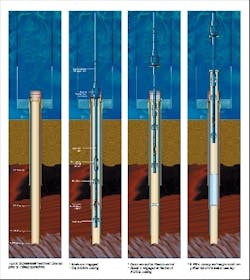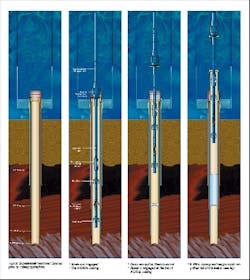DRILLING TECHNOLOGY: Multi-function fishing tool strings used on Africa, US Gulf P&A operations
Rig costs and other factors associated with extreme water depths make any opportunity to improve efficiencies and economics of subsea plugging and abandonment (P&A) operations wel-come. Multi-function fishing tools recently developed can minimize the number of trips required during casing and wellhead recovery, and operators off West Africa and in the Gulf of Mexico have saved time with these new systems.
One new P&A system, developed by Baker Oil Tools, saves trips, reduces pipe-cutting time, and prevents wellhead damage. The system consists of a retrieving tool for all wellheads, a Hercules Multi-String Cutter, an advanced hydraulic casing spear, and combination marine swivel/seal extractor.
Before the development of the multi-function fishing tools, recovering a subsea wellhead was time-consuming and cost-intensive. Typically, three or more drillpipe trips were required to remove each intermediate casing string. The first trip retrieved the casing hanger seals from the wellhead. The casing was cut with a second trip. A third trip was then required to remove the casing and casing hanger from the well. This three-trip process would be repeated for each intermediate casing string to be recovered. Following recovery of all intermediate casing strings, the conductor strings were cut just below the mudline and the wellhead was recovered.
During the past decade, advances in "cut-and-pull" technology have consolidated cutting and recovery of the wellhead into a one-trip procedure. Still, multiple trips have been required for each intermediate casing string. Rig time consumed by these trips is a function of water depth. In deepwater operations, 8-10 hours per round trips are common. Added to that is time required for pipe cutting operations. Pipe cutting for the large-diameter (20-36-in.), thick-walled (1-1/2-in.) conductor casing that ties into subsea wellheads often requires 7-10 hours using conventional cutting equipment.
Currently, day rates for deepwater rigs are in the $200,000-250,000 range, over $8,000 per hour. Thus, the potential savings from eliminating one trip are in the range of $75,000. For a typical subsea well with two intermediate strings to recover, elimination of two trips per string can save $300,000. This is a significant saving for an overhead operation with no revenue generation.
Multi-string casing cutter
The cutters used to cut the intermediate casing strings are designed to cut quickly. The multi-string cutter (Hercules) is an improvement to a basic design that has been in service for three decades. The cutter is equipped with knives that are pivoted into the pipe to sever the casing. Circulation through the cutter produces a pressure differential across a large piston in the cutter. The resulting force acts on a cam surface on the inner end of the knives, pivoting them into the casing. Improvements to the cutter provide an increased cross-section in the knives to handle greater bending moments and improvements to the hydraulic "tattle-tail" feature. This provides a surface indication once the knives have extended far enough to complete the prescribed cut.
Knives of different lengths are available to cut a single pipe string or to progressively cut multiple strings. An adjustable internal stop is set to control the maximum knife-cutting diameter.
The most reliable and rugged knife dressing is the generally cylindrically shaped, sintered tungsten, and carbide button. Development of the button configuration has been refined to consistently produce small cuttings that are easily circulated out of the wellbore and minimize the risk of interfering with tool operation.
Specifically targeted at the wellhead recovery system, the updated cutter employs a solid body design that allows for a more robust knife design. The cutter can also be fitted with a special large outside diameter sleeve to provide maximum stabilization when run to cut the larger diameter conductor strings. Stabilization is the key to providing speed and endurance for maximum performance. The sleeve also eliminates the need for added stabilizers in the workstring.
Combination extractor
The swivel design is one of the key trip-saving elements of the intermediate casing string recovery system. The swivel allows accuracy in locating the casing cut, and provides a stationary position during the cutting process. The swivel is equipped with a seal-pulling adapter according to the wellhead manufacturer's specification, allowing for seal removal after the cutting process is completed. The swivel can be equipped to accommodate any 18-3/4-in. wellhead straight-pull release hanger seal.
The design allows the casing string to be cut with the hanger seals locked in to the wellhead, preventing the hanger from moving after the cut is made. Such movement can scar and damage the inside of the wellhead. With the seal unlocked and retracted, the hanger can be pulled and recovered in the same trip.
The swivel is equipped with robust radial and axial thrust bearings. A pressure compensator equalizes the pressure on the bearing lubricant, equalizing the pressure across the bearing seals. Porting in the lower housing allows unrestricted circulation during the cutting operation.
Hydraulic spear
The hydraulic casing spear is the final key component of the one trip cut-and-pull system for intermediate casing string recovery. The spear is hydraulically operated and eliminates the need for right or left-hand rotation to set or release the spear. A high load spring maintains the slips fully retracted until engagement of the casing is required. After the casing string is cut and the workstring is elevated, releasing and pulling the hanger seals if applicable, the hydraulic spear is positioned just below the casing hanger.
Proper loading of the cutter knives depends on the opportunity to control the circulation rate through the cutter. Since engagement of the casing with the spear is also a function of circulation rate, it is necessary to ensure that the flow required to perform the cut will not activate the spear. This is accomplished by providing a metering sleeve that is lubricated down the work string after completion of the cut.
Once the metering sleeve is set, fluid circulation at a predetermined rate sets the spear. With the casing securely engaged, the workstring is elevated once again and the casing is then pulled free to the rig floor. The spear is run one joint above the cutter so that no timely stripping is required once the casing is set in the slips at the rig floor. Simply dropping a ball and pressuring the workstring releases the spear. The casing is then laid down. Slips are available for all casing sizes from 9-5/8 in. to 13-3/8 in. Change out of the slips is readily accomplished on the rig although normal practice is to have a different spear on hand for each casing size to be recovered.
The Universal Wellhead Retrieving System (UWRS) is a combination latching tool and marine swivel. The system is run above the multi-string cutter to secure the wellhead during the cutting process and recover the wellhead once it is severed from the cemented conductor strings. The UWRS is designed to catch all manufacturers' 18-3/4 in. subsea wellheads with minor reconfiguration.
Earlier wellhead recovery tools relied on wellhead-specific adapters to engage proprietary profiles on the wellhead housing or wickered slips to engage the bore of the wellhead. These designs have proven troublesome. They must provide precisely mated engaging hardware for a variety of wellhead designs that employ the profile engagement style. Certain damage can also occur to the polished bore for wellheads using the slip style engagement.
With the system, a shoulder beneath the wellhead polished bore is engaged in tension with a collet system. A J-slot in the top of the UWRS controls the setting and releasing of the collet from the wellhead. The UWRS is run with the J-slot latching the collet in the release position. With the tool shouldered on top of the wellhead, one-quarter turn rotation to the left allows the inner mandrel to release from the run-in position and to be raised, locking the collet into the wellhead. An over-pull can then be taken on the drillstring. If the tool string must be recovered prior to completely severing the wellhead, slacking off on the drillstring disengages the collet. When the inner mandrel is lowered, it will automatically re-engage the J-slot to maintain the collet in the released position.
Once set in the subsea wellhead, the wellhead retrieval system allows tension to be maintained on the work string during the cutting process. The thrust bearings in the system are rated for an over-pull of up to 300,000 lb during rotation to cut the pipe. To recover the wellhead, which may be seated with considerable friction to the seabed, the UWRS is rated for 1,240,000 lb of static pull.
Severing of the 20-in. casing below the wellhead and 30 in. or larger conductor string is accomplished with the previously described multi-string cutter. For this operation, the multi-string cutter is fitted with knives of sufficient length to cut both pipe strings. During the cutting process, the pipe cross-section being cut increases substantially. To achieve optimum performance from the cutter, it is therefore important to be able to raise the force applied to the cutter as the cut proceeds. This is accomplished simply by increasing the fluid circulation rate, which in turn increases the differential pressure across the piston in the cutter and the force exerted against the knives.
Field operations
Operators in West Africa and in the Gulf of Mexico were the first to use the new deepwater P&A system. In two recent applications in 2,500-ft depths off West Africa, the UWRS was used with 100% success. In one well using the UWRS and a conventional cutter, a single string was cut in eight minutes of cutter operation.
An operator in the Gulf of Mexico used the UWRS and the Hercules cutter to cut two strings of casing in 2 hours and 8 minutes. The 20 in. and 36 in. diameter fully cemented casings were cut and the wellhead removed in one trip as part of a P&A operation in 4,500 ft water depths. Where no cement is present between the two strings, substantially more rotating time may be required to complete the cut.
The UWRS and multi-string cutter work together to keep the work string in tension while cutting. The ability to cut in tension creates less pipe fatigue due to bending in the work string. Cutting the casing in tension also provides a more efficient cut as it ensures that the weight of the dutchman never slacks off onto the cutter knives.
The four tools introduced to improve efficiency of subsea P&A operations are meeting the design goals of improved operating efficiency and reliability.
Acknowledgement
The authors thank Baker Oil Tools for allowing publication of this material. Bobby Belote, Robbie Colbert, and Dave Stephen of Baker Oil Tools provided field operation data, and Frank Radez of Baker Hughes, Inc. assisted.
References
Davis, J., Lynde, G., Casing Cutter Blade Support Sleeve, U.S. Patent No. 6,125,929, October 3, 2000.
Davis, J., Wellhead Retrieving Tool, U.S. Patent No. 6,059,049, May 2, 2000.

